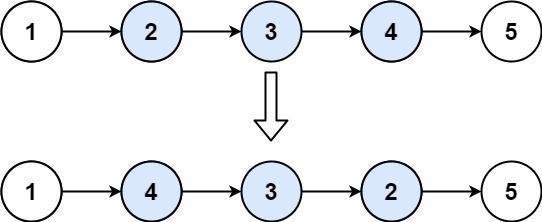给你单链表的头指针 head 和两个整数 left 和 right ,其中 left <= right 。请你反转从位置 left 到位置 right 的链表节点,返回 反转后的链表 。
示例 1:
输入:head = [1,2,3,4,5], left = 2, right = 4 输出:[1,4,3,2,5]
示例 2:
输入:head = [5], left = 1, right = 1 输出:[5]
提示:
- 链表中节点数目为
n 1 <= n <= 500-500 <= Node.val <= 5001 <= left <= right <= n
进阶: 你可以使用一趟扫描完成反转吗?
# Definition for singly-linked list.
# class ListNode:
# def __init__(self, x):
# self.val = x
# self.next = None
class Solution:
def reverseBetween(self, head: ListNode, m: int, n: int) -> ListNode:
if head is None or head.next is None or m == n:
return head
dummy = ListNode(0)
dummy.next = head
pre, cur = dummy, head
for _ in range(m - 1):
pre = cur
cur = cur.next
p, q = pre, cur
for _ in range(n - m + 1):
t = cur.next
cur.next = pre
pre = cur
cur = t
p.next = pre
q.next = cur
return dummy.next/**
* Definition for singly-linked list.
* public class ListNode {
* int val;
* ListNode next;
* ListNode(int x) { val = x; }
* }
*/
class Solution {
public ListNode reverseBetween(ListNode head, int m, int n) {
if (head == null || head.next == null || m == n) {
return head;
}
ListNode dummy = new ListNode(0);
dummy.next = head;
ListNode pre = dummy, cur = head;
for (int i = 0; i < m - 1; ++i) {
pre = cur;
cur = cur.next;
}
ListNode p = pre, q = cur;
for (int i = 0; i < n - m + 1; ++i) {
ListNode t = cur.next;
cur.next = pre;
pre = cur;
cur = t;
}
p.next = pre;
q.next = cur;
return dummy.next;
}
}
